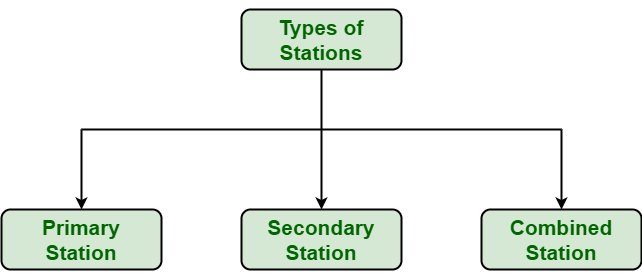Type of Stations for HDLC Protocol
Last Updated :
30 Jul, 2020
High-Level Data Link Control (HDLC) is basically bit-oriented protocol for communication that means it uses bit stuffing to achieve data transparency over very point-to-point and multipoint links in Data Link Layer (DLL). Transparency is basically separation of data from control signals. HDLC was being derived from Synchronous Data Link Control (SDLC).
HDLC is most important and essential protocol in data link layer. Data is also organized and divided into small units also known as data frames and is transferred across network to destination that verifies and ensures its successful arrival. ITU (International Telecommunication Union) simply modified HDLC for the use in X.25 network interface and called it LAPB (Balanced Link Access Protocol). It is the most essential protocol because of the following reasons :
- HDLC was highly developed and used by International Organization for Standardization (ISO) for point-to-point communication.
- HDLC uses similar format and mechanisms as that of other essential data link protocols.
- It also supports full-duplex communication or transmission as well as half-duplex communication or transmission.
Types of Stations :
HDLC generally specifies the three types of stations for data link control as given below :

- Primary Station :
Primary Station simply takes care of data link management. The main responsibility of primary station is to control operation of all other stations on links. It usually acts as master and controls operation of secondary stations and also handles error recovery at data link layer. It also manages and controls connection to all secondary sessions by sending commands.
A primary issue basically commands and secondary issues basically responses. Commands are actually frames that are issued by this primary station. This station is also responsible for error detection, line control, and control of data flow. To communicate with Secondary stations, it requires use of unbalanced mode. The primary station is responsible for connecting and disconnecting data link in case of communication among primary and secondary stations.
- Secondary Station :
Secondary stations generally give responses to commands that are sent from primary station. This station act as slave and basically operates and works under control of primary station. It only transmits or sends response frame when this response frame is being requested by primary station. Responses are frames that are issued by secondary station. These stations are usually terminals that are attached to mainframes.
A secondary station has no ability, or have direct responsibility to control data link. An unbalanced mode is communication among primary and secondary stations.
- Combined Station :
Combined Station as name suggests generally acts as combination of both primary and secondary stations. It establishes and tears down their own connections. The combined station usually issues both command or response. The balanced mode is communication among two combined stations. Each of combined stations is fully in control of itself and does not even rely on any of other stations on data link.
Combined stations are generally used and required in point-to-point serial links like V.35 link to CSU/DSU (Channel Service Unit / Data Service Unit) or among various connected routers by T1 or frame relay.
Like Article
Suggest improvement
Share your thoughts in the comments
Please Login to comment...